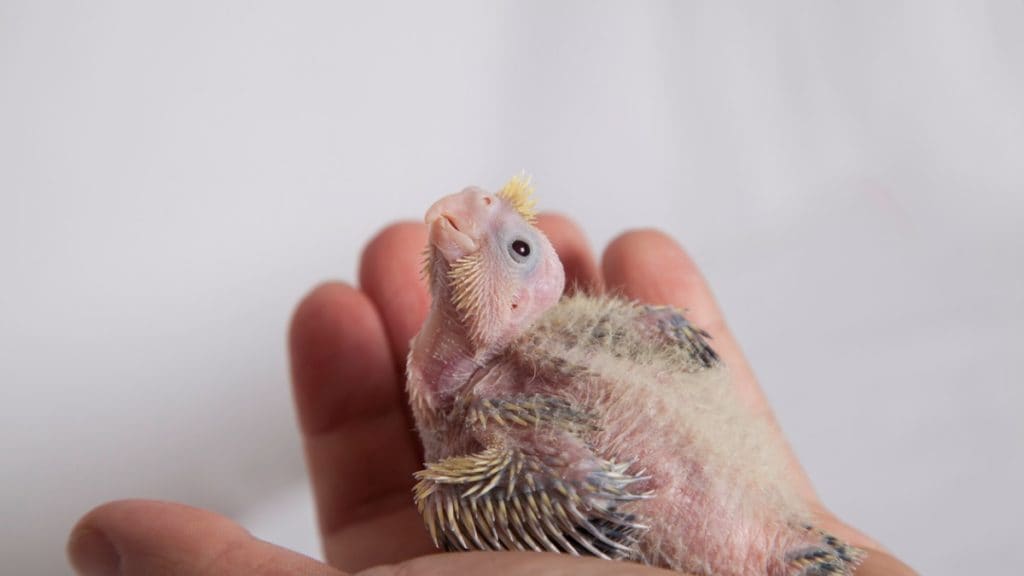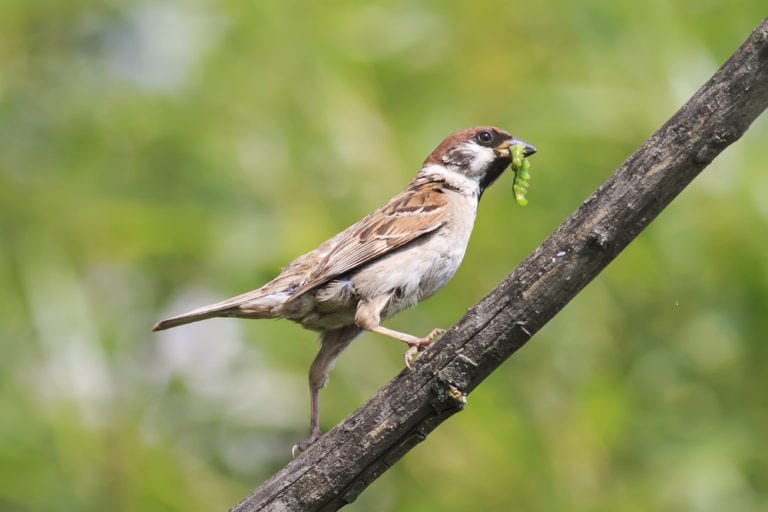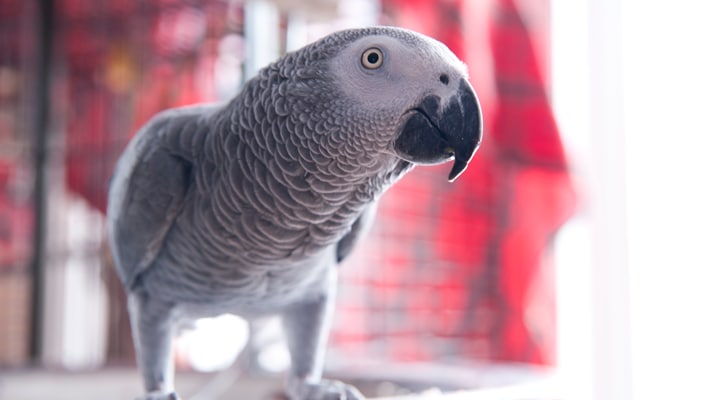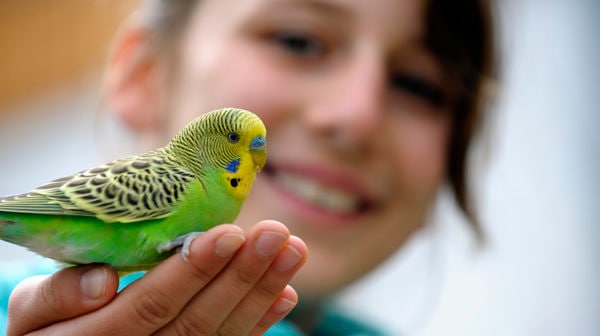It can be a nerve-wracking experience to discover a newborn or very young cockatiel unexpectedly hatched out and abandoned by one or both parents. Once you are absolutely certain that a baby cockatiel is not being fed or consistently brooded and kept warm by its parents, you must act.
Baby birds that are well cared for have food in their crops — the little “sacks” under the throat located at the top of the breast. The parent birds pump food down the crop by grasping and shaking the baby bird’s beaks vigorously. Healthy youngsters scream for food and the adults first feed those that scream the loudest. Well-cared for baby birds are continuously brooded, nap contently between feedings, kept warm by their parents, and prevented from wondering away where they can grow cold and die.
In an ideal situation, aviculturists who raise cockatiels will attempt to find another pair of breeding birds with babies the same age so they can foster out the young. If the baby birds are too far apart in age, the foster parents might attack the newcomers, so it is critical that the babies’ ages are within days of one another.
However daunting at first, hand-feeding a single baby cockatiel can be successful providing you are fully committed from the start. Baby cockatiels require constant attention; if you are unable to be consistent or make the commitment, then you might have to find another solution.
When first hatched, a baby bird’s chance of survival during the first few days — especially with a new inexperienced hand-feeder — is very slim. Even experienced hand-feeders can lose babies that are under a week of age. This can be due to underdeveloped immune systems that would thrive better when fed by the baby bird’s parents, whose crop contents provide the natural flora and beneficial bacteria to ensure survival. Out of all the parrot species, the cockatiel is most sensitive to crop impaction. Crop impaction, or “sour crop,” is when the crop walls begin to slow down and digestion stops, leading to serious complications that are fatal if unattended.
Upon first discovering an unattended baby cockatiel, the most critical need to address is body temperature. Warming up the baby is not only essential to its overall survival, it is crucial to its ability to digest food. Never feed a cold baby! It is a guaranteed journey to an impacted crop.
Lacking a commercial brooder or incubator, home-made brooders can easily be built. Place a clean, empty aquarium or shoe box on top of a heating pad set to “medium” for a make-shift brooder. Towels can be partially draped to create more insulation if needed. Watch that baby birds do not become over-heated, or they can suffer heatstroke and die. Cockatiel babies that are too hot have gaping, wide-open beaks, while opening their tiny wings away from their bodies in an effort to keep cool. Baby birds that are too cold shiver, are restless, cry, and are unable to sleep. A thermometer is an excellent tool to keep track of temperature.
Babies between two and a half, to three weeks of age, may be kept in an environment between 92 and 94 degrees Fahrenheit. Gradually reduce the heat over time as the babies continue to feather, until reaching 86 degrees. At five to six weeks of age, move the babies into a cage so they may learn how to eat and perch; however, return them to the heated brooder at night to sleep. The babies will require another two or three weeks to wean and become completely self-sufficient. Gradually reduce the heat further over time, until they are weaned and sleeping comfortably on their own, and can remain full time in their new cage.
For single baby birds that have no siblings to cuddle with, a small paper cup stuffed with clean tissue paper provides superb support for drooping heads due to weak developing neck and can easily be changed with each feeding to keep the nest clean.
Fortunately, a variety of hand-feeding formulas are available today at local pet retailers that are ideal for hand-feeding baby cockatiels. Follow manufacturer’s instructions to the letter; each brand is different and prepared in a slightly different manner. Whichever brand you choose, always prepare fresh formula for each meal, discarding whatever is left over. Feeding leftover formula or formula that is not warm enough will impact a baby’s crop. Feeding formula that is too hot will scald the crop and cause serious, painful crop burn, requiring immediate veterinary emergency care for the baby bird to survive. Always test formula on the inside of your wrist — if it burns you, it will certainly burn the baby bird’s crop.
When attempting its first feed, you can try to drip a drop of formula onto the side of the baby bird’s beak; it will usually respond to the warmth and suck it in. If you lack a syringe, use a spoon with the sides curved upward. Another trick is to give a gentle “pinch” just like the parent grasping the baby bird’s beak. A baby usually responds by opening its beak, allowing you to slowly feed a small amount of food until it gets the idea to swallow. The chick will begin to vigorously pump its head up and down (at times almost too fast for the human eye!) hungrily taking in the formula.
Be careful not to feed too quickly or to overfeed, which can cause a chick to aspirate the food back down its windpipe. If you need to re-warm formula during feedings, either prepare a new batch, or (if the manufacturer’s instructions allow) heat a small glass of hot water and place the container of formula within it to keep it warm.
It is always better to feed too loose a formula and feed more often until you and the baby can learn a schedule together. If fed too thick, a heavier formula can impact the crop. After feeds, clean the beak, face or other soiled feathers with a clean cloth or tissue. Dry, and return the baby bird to its warm environment immediately so it can digest its food. Sterilize all utensils and syringes in a good disinfectant, which is obtainable at a local animal hospital or hospital supplier.
If a baby bird’s crop fills with air, massage is the correct treatment if you are able to gently burp the air out without aspirating the food up at the same time and risk the food going back down the windpipe. Frequent massages might be required. Air in the crop, however, is often a sign of further problems. If it does not resolve quickly, becomes worse or is accompanied by other problems, a veterinarian specializing in avian medicine should be sought.
For an avian veterinarian near your location, visit The Association of Avian Veterinarians. There is a listing for the public to find veterinarians whose practice includes birds, both within and outside the USA.
Newborns and tiny cockatiel babies require feeds at least every hour, then every two hours around the clock, with an eventual four-hour break at night near one week of age. Some cockatiel providers are able to arrange for more than one hand-feeder to take over at least part of the time, which greatly reduces the stress on the human caregiver. Most aviculturists will not “pull” baby birds for hand-feeding under 2 1/2 weeks of age, because baby birds require too many feeds each day. Waiting beyond 18 days can be tricky, because cockatiel babies are afraid of humans at that age and will often refuse food and be impossible to feed. Timing is everything!
In the event that a parent cockatiel is interested in feeding, assisting or even brooding its young, it might be given the opportunity to do so. A close and careful watch is necessary to be certain the baby is properly cared for. Another option is to allow supervised visits, without chilling the baby or interrupting its digestion if it is on formula.
In general, 3-week old cockatiel babies usually require five feeds per day; 4-week old babies require four feeds; 5-week old babies need three feeds daily; 6-week old baby birds are usually down to two feeds per day; and 7 week-olds usually require only nightly feedings until they are weaned at 8 weeks of age.
Of course, this is an “ideal schedule” of averages and does not account for individuality, slow growers, early problems or special needs. Some baby birds that start off slow easily catch up with maturity. Many aviculturists, the author included, have on occasion fed babies for one reason or another until it was 10 weeks of age. I’ve heard of longer, but that would usually point to other problems. However, never, ever, allow a cockatiel baby to go to bed hungry! If a baby bird’s crop is not full and round at bedtime, feed it you must. Weaning will occur when the cockatiel baby is developmentally ready to wean, and not before!
By 4 weeks of age, the “pin-cushion” you have been feeding will be fully feathered with a short little tail and can be kept in a larger aquarium or bird cage, protected from drafts, with food on the floor so it will learn to sample such dietary items. Tempting foods include millet spray; cockatiel bird food and fresh seed mix; stone ground whole-wheat bread; breakfast grains, such as shredded wheat or Cheerios; a corn, rice, and bean mix; corn on the cob; fresh, dark-green leafy vegetables, such as dandelion spinach, broccoli, parsley, carrots (including tops), among others; and other soft foods in moderation. Always supply clean drinking water, because cockatiel chicks wean faster when water is made available to them.
Today, the mind-body connection in medical and health issues is more widely accepted. Similarly, the mental bond that can be established between a care-giver or hand-feeder and their charge can, and often does, pull an animal through to flourish successfully. The sheer power of devotion, connection and perseverance in the survival of a helpless baby that is dependent upon its caregiver can make all the difference in the world.
Posted by: Chewy Editorial
Featured Image: iStock.com/Cerenzio
Share:









